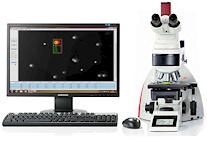Mini-gel comet assay working with metallic nanoparticles.
- Details
- Created: Tuesday, 10 April 2018 11:08
Resea rchers from the Karolinska Institutet, RECETOX at the Masaryk University and KTH Royal Institute of Technology worked in collaboration to study the size-dependent genotoxicity of silver (Ag), gold (Au) and platinum (Pt) nanoparticles (NPs). During the investigation they used the mini-gel comet assay and flow cytometry micronucleus scoring.
rchers from the Karolinska Institutet, RECETOX at the Masaryk University and KTH Royal Institute of Technology worked in collaboration to study the size-dependent genotoxicity of silver (Ag), gold (Au) and platinum (Pt) nanoparticles (NPs). During the investigation they used the mini-gel comet assay and flow cytometry micronucleus scoring.
It is well known that metallic NPs are promising nanomaterials used in different technological solutions as well as in consumer products. Ag, Au and Pt represent three metallic NPs with current or suggested uses in different applications. Pt is also used as vehicle exhaust catalyst leading to a possible exposure via inhalation.
Despite their use, the investigators report that there are limited data on their genotoxic potential and possible size-dependent effects, particularly for Pt NPs. In addition, the researchers felt that due to the inconsistencies in previous studies for all these NPs and limited available scientific data for Pt NPs, they would focus the present study on revealing possible size-dependent genotoxic effects of Ag, Au and Pt NPs. As the team was particularly interested in lung genotoxic effects following inhalation of Pt NPs, human bronchial epithelial cells (HBEC) were used.
The aim of this study was to explore size-dependent genotoxicity of these NPs (5 and 50 nm) following exposure of human bronchial epithelial cells. The scientists characterized the NPs and assessed the viability (Alamar blue assay), formation of DNA strand breaks (mini-gel comet assay) and induction of micronucleus (MN) analyzed using flow cytometry (in vitro microflow kit).
Full experimental details can be found in the original publication, including:
- NPs and characterization of size,
- Characterization and calculation of electrophoretic mobility and zeta potential,
- Cell culture conditions and exposures,
- Cell viability assessment,
- Genotoxicity assessment using mini-gel comet assay,
- Genotoxicity assessment using micronucleus assay,
- Statistical interpretation.
 Here, we briefly re-cap the genotoxicity assessment using mini-gel comet assay:
Here, we briefly re-cap the genotoxicity assessment using mini-gel comet assay:
The alkaline comet assay, also known as single cell gel electrophoresis, was used to detect single and double DNA strand breaks as well as alkali labile sites. HBEC cells were seeded in 24-well plates and exposed to Ag, Au and Pt NPs (5 and 50 nm) at several concentrations for 48 h. Cells were harvested, then aliquots were added as drops onto cold microscope slides pre-coated with agarose. Two gels on different slides were made for each sample and eight mini-gels were prepared on each slide. Cells were lysed on ice for 1 h in dark conditions. They were then placed in alkaline buffer for unwinding. Afterwards, electrophoresis was performed, then samples were neutralized, dried overnight and fixed in methanol. DNA was stained by immersing air-dried slides in 1:10000 SYBR-green. Scoring was performed using a fluorescence microscope (Leica DMLB, Meyer Instruments, Inc., Houston, TX) with the Comet Assay IV software (Instem / Perceptive Instruments Ltd., Suffolk, UK). One hundred cells were scored per sample (50 comets on each duplicate gel) and results were expressed as mean of percent DNA in tail. Exposure to hydrogen peroxide (20 μM) for 5 min was used as a positive control. Three individual experiments were performed for each particle and concentration.
In the publication, the author explains that the results confirmed the primary size (5 and 50 nm) showed agglomeration of all NPs in the serum free medium used. Cell viability (which was tested up to 50 µg/ml) was observed following exposure to the Ag NPs of both particle sizes, as well as to the smallest (5 nm) Au NPs. Both 5 and 50 nm-sized Ag NPs, as well as 5 nm-sized Au NPs, increased DNA strand breaks. Only the 50 nm-sized Pt NPs caused a slight increase in DNA damage. No clear induction of MN was observed in any of the doses tested (up to 20 µg/ml).
The scientists concluded from the comet assay data that DNA strand breaks were induced by Ag NPs, without any obvious differences in NP size, whereas effects from Au and Pt NPs were size-dependent. No clear induction of MN was observed for the NPs.
For a full discussion of all the data in this study, please refer to the original publication:
Size-dependent genotoxicity of silver, gold and platinum nanoparticles studied using the mini-gel comet assay and micronucleus scoring with flow cytometry Mutagenesis, Volume 33, Issue 1, 24 February 2018, Pages 77–85,
